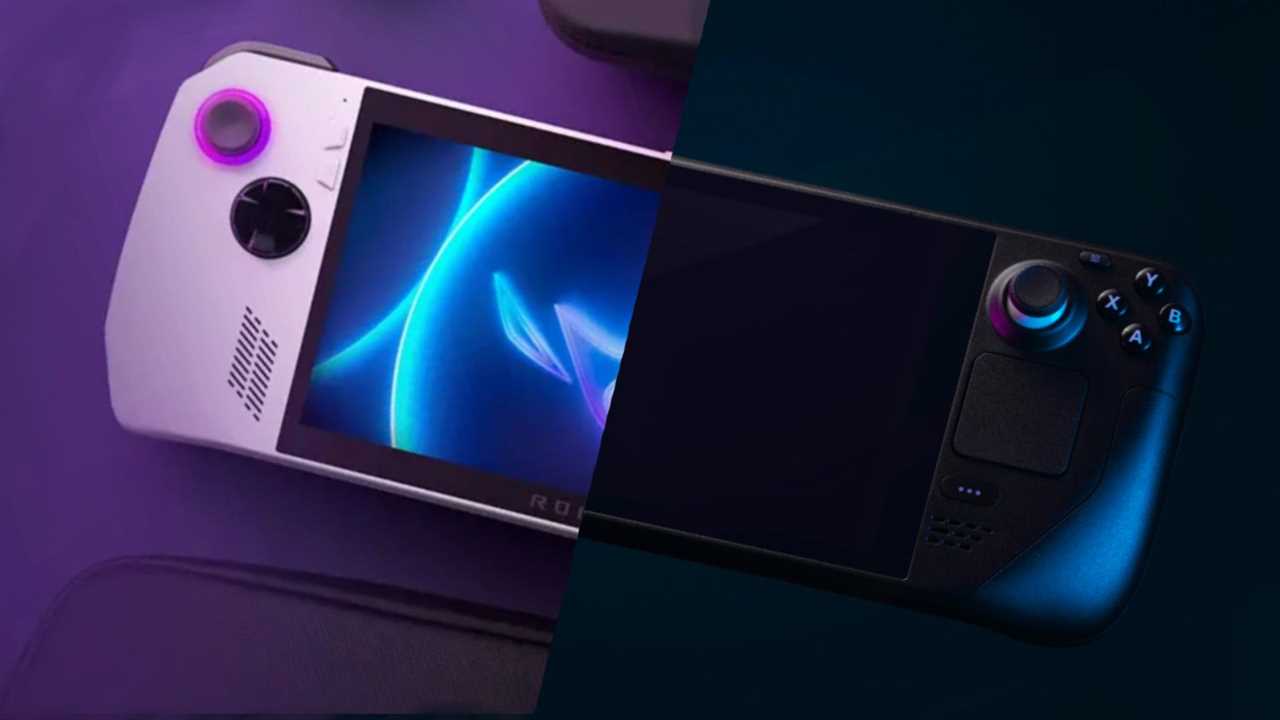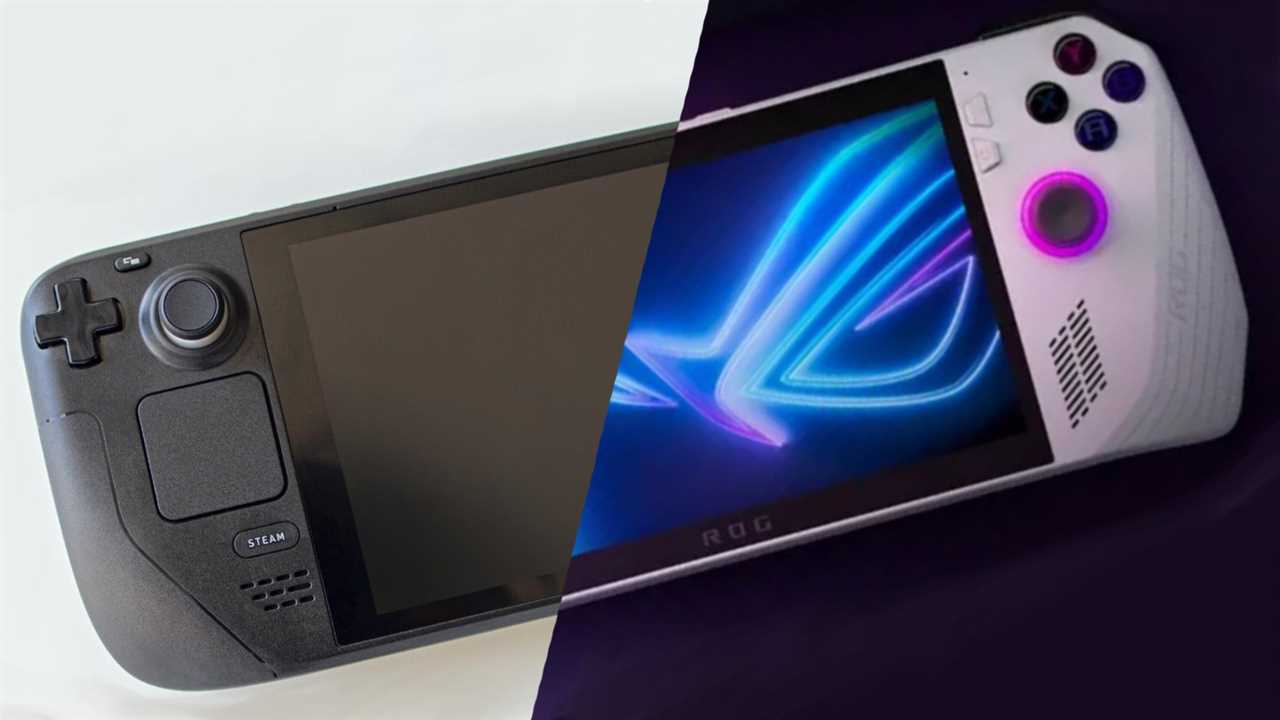ASUS recently revealed the ROG Ally, a handheld gaming PC to rival the Steam Deck.
The Steam Deck has been wildly successful as gamers are turning to portables to get their gaming fix.

Both the Steam Deck and the ROG Ally offer gaming on the go.
Now the Asus ROG Ally is entering the arena, hoping to take over as the next big thing.
If you’re not sure which console is best for you, we have a breakdown of everything you need to know.
Is the Steam Deck or the Asus ROG Ally bigger?
Both consoles are roughly the same size, but the Steam Deck is a little larger.
The Steam Deck is 29.8 x 11.7 x 4.9cm, while the Ally is a little slimmer in every measurement at 28 x 11.3 x 3.9cm.
While this isn’t a lot, it might seem a lot bigger when playing, especially the 1cm reduction on thickness.
The Ally is also 61g lighter, down to 608g from the Steam Deck’s 669g.
Both are much larger than the Nintendo Switch OLED if you have this as a basis of comparison.
Which screen is better: Steam Deck or Asus ROG Ally?
Both handheld PCs will have the same size screen which is 7in across. They are also both LCD.
Despite this, there is a big difference when it comes to the look of the screen, which is due to the resolution.
The Deck’s screen is 1280x800p, which means it offers 720p HD as the maximum resolution.
By comparison, the Ally’s screen is 1920x1080p offering a higher resolution of 1080p HD.
Basically, what this means is that despite the screens being the same size, games on the Ally will look better.
Does the Asus ROG Ally or the Steam Deck have more storage?
There are three versions of the Steam Deck, and for the purpose of this comparison, we’re comparing against the most expensive model.
This is the most powerful model of the Deck and the one that is probably closest to what the Ally has to offer.
In this case, both models offer the same amount of storage. They both have 16GB of RAM.
They also both have 512GB SSD storage, which will allow you to have a number of beefy games installed.
Is the Asus ROG Ally more powerful than the Steam Deck?
This is a difficult one to estimate, but the answer is ‘probably’.
To start, Ally has a refresh rate of 120hz compared to Deck’s 60hz. This means that the Ally can run games at 120fps, and Deck at only 60fps.
This is more to do with the screen than the overall power, but the Ally also has the power to support it.
The Steam Deck’s processor can handle 1.6Tflops, while the Ally will support a minimum of 2.8Tflops.
Essentially, the Ally will have 150% of the Deck’s processing power, though there are rumours that there may be a more powerful version of the Ally released.
This one could have graphical processing up to an impressive 8.6Tflops. This is not as impressive as the PS5, but far outstrips other handhelds on the market.
Which has the better battery life: Steam Deck or Asus ROG Ally?
The Steam Deck is known for having a pitiful battery life. While the specs claim it has 2-8 hours of play time, playtesting is well below this.
Reports have seen play time of around 30 to 45 minutes as being normal for more intensive games like Elden Ring.
Indie and 2D games fare better, but you are unlikely to see your battery last for more than 4-6 hours even with this type of game.
Despite this the Asus ROG Ally’s battery life may be even worse. The pair have a similar battery, but the more powerful Ally is likely to drain it faster.
This isn’t a given, but it is the best estimation we can give without play testing.
Is the Asus ROG Ally or Steam Deck easier to play?

Both offer a different experience to gamers.
The Deck runs on the SteamOS, which is a version of Linux, while the Ally runs on Windows.
People are more likely to be familiar with Windows which could be helpful, but Linux is by far the more stable platform.
It’s less likely to crash, has incredibly stable updates, and is known for not being susceptible to computer viruses.
The same goes for the controller and the control scheme. Both consoles have remappable controls so you can change them to suit you.
However, the Steam Deck has far more buttons, including touch pads and extra buttons making it more accessible.
If you’re not really into customising controllers, you might be more comfortable with the Ally’s limited layout.
When it comes down to it, both are a question of personal preference.
The Ally will come with three months of Xbox Game Pass Ultimate, so if you don’t have a big library of Steam games, it will give you a place to start.
What is the price difference between the Steam Deck and the Asus ROG Ally?
The Steam Deck comes in three versions, with the version most closely resembling the Ally costing £569 ($649).
The Asus ROG Ally’s price will be officially announced on May 11, but the company has given us a vague idea of pricing.
It will apparently be “competitively” priced, and be “comparable” with the Steam Deck’s price.
Asus has also said it will definitely cost less than $1000 (£800).
Despite this, it’s probably safe to say that the Ally will be more expensive than the Steam Deck.
We expect it to sell somewhere around the $800 (£650) price range.
Steam Deck vs Asus ROG Ally: A full comparison
Here are all the specs and stats compiled.
- Resolution
- Steam = 1280x800p
- Asus = 1920x1080p
- Refresh Rate
- Steam = 60hz
- Asus = 120hz
- Screen Size
- Steam = 7”
- Asus = 7”
- Screen Type
- Steam = LCD
- Asus = LCD
- Weight
- Steam = 669g
- Asus = 608g
- Operating System
- Steam = Steam OS (Linux)
- Asus = Windows
- Size
- Steam = 29.8 x 11.7 x 4.9 cm
- Asus = 28 x 11.3 x 3.9 cm
- Storage
- Steam = 512 GB SSD
- Asus = 512 GB SSD
- RAM
- Steam = 16 GB
- Asus = 16 GB
- Battery
- Steam = 40wh
- Asus = 40wh
- GPU
- Steam = 1.6 Tflops
- Asus = 2.8 Tflops
- Adaptive Controls
- Steam = Yes
- Asus = No
- Price
- Steam = $649 (£569)
- Asus = <$1000 (<£800)
Overall comparison
In terms of specifications the ROG Ally is the clear winner, with more powerful processing, better resolution and higher frame rate.
However, the Steam Deck has the edge when it comes to accessibility with the better control scheme, and solid OS.
In terms of games it will depend on whether you have a good number of games in your Steam library.
If you favour Xbox Game Pass, or DRM-free, you will likely want to go with the Ally, though most players will likely have a good selection from Steam sales.
I think for most people the decision will come down to the price point.
With the Ally being more expensive, we still expect people to opt for the Steam Deck.
However, if it ends up as competitively priced as Asus claims then it could be stiff competition.
Written by Georgina Young on behalf of GLHF.
Did you miss our previous article...
https://trendinginthenews.com/gaming/volcarona-makes-its-debut-this-week-in-pokmon-go






